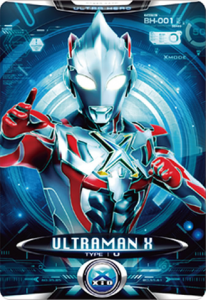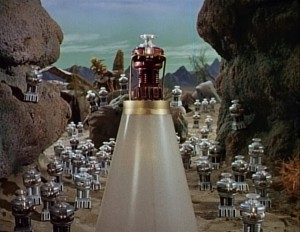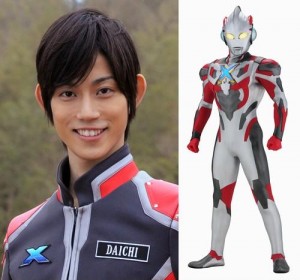This is a short entry. Today is my birthday (my 50th) and I’m spending it all with my family and dear friends.
 A while back, I reviewed Ultraman Mebius, a series from 2007 which continued the very successful Ultraman franchise. I believe I explained then that Ultraman was a character created by Eiji Tsuburaya, also the creator of Godzilla, in 1967. The show had been imported to the US shortly thereafter, and was a big hit with kids my age in the early 70s. Mebius was the 40th anniversary tribute series, and I fell in love with it as soon as I saw it.
A while back, I reviewed Ultraman Mebius, a series from 2007 which continued the very successful Ultraman franchise. I believe I explained then that Ultraman was a character created by Eiji Tsuburaya, also the creator of Godzilla, in 1967. The show had been imported to the US shortly thereafter, and was a big hit with kids my age in the early 70s. Mebius was the 40th anniversary tribute series, and I fell in love with it as soon as I saw it.
Since then, Tsuburaya Productions has released a couple of other series, including Ultraman Ginga. I didn’t watch it, and I got the impression it largely existed to market toys. Apparently, its premise was that all the Ultramen and all their monster foes had been turned into vinyl miniatures call Spark Dolls. None of the subsequent series seemed to hold the same interest for me that Mebius did.
But I was fairly excited when Ultraman X was announced earlier this year. Ultraman X is the 27th series in the franchise. Like its immediate predecessor, Ginga, it has toy marketing as an angle. Like Mebius and most of the others, it features an all-new cast and original stories. It also follows the classic Ultraman formula: there’s a team of highly trained, super-scientific specialists, Japanese, but with international connections, whose job it is to fight Kaiju–giant monsters who threaten humanity. They have futuristic weapons, amazing vehicles, and a giant, alien super-hero named Ultraman comes to their aid whenever they can’t defeat a monster on their own. That’s every episode, of course, or the show wouldn’t always have “Ultraman” in its name.
While the faces of the cast and the design of Ultraman X’s costume are new, the monsters Ultraman fights are not. They are old favorites. That’s part of the charm of Ultraman. While the new vehicles and weapons are CGI animated, as are the sequences were Ultraman interacts with his human partner, the action of giant man versus giant monster looks just like it did in 1967–two guys in rubber suits battle it out, smashing miniature buildings galore as they go. The genre is called tokusatsu in Japanese.
 The specific premise is straightforward. Fifteen years ago, mysterious solar flares caused toy monsters called Spark Dolls to enlarge and come to life as Kaiju. (Spark Dolls are real–barely articulated vinyl miniatures, produced in Japan but readily available in the U.S. via Amazon and other outlets. That’s the toy-marketing aspect of all this, and it’s kinda cool for children watching the series. Imagine being able to own the exact miniatures that your heroes on TV were carrying around. Not since Lost in Space featured actual Remco toy robots have kids had such an opportunity.)
The specific premise is straightforward. Fifteen years ago, mysterious solar flares caused toy monsters called Spark Dolls to enlarge and come to life as Kaiju. (Spark Dolls are real–barely articulated vinyl miniatures, produced in Japan but readily available in the U.S. via Amazon and other outlets. That’s the toy-marketing aspect of all this, and it’s kinda cool for children watching the series. Imagine being able to own the exact miniatures that your heroes on TV were carrying around. Not since Lost in Space featured actual Remco toy robots have kids had such an opportunity.)
 To fight these evil toys, an international coalition founded XIO (Xeno Invasion Outcutters), a group of highly trained professionals who… you read that part already, right? Prominent among the ranks of XIO is Daichi, who was but four years old when the solar flares first brought the monsters to life. His father entrusted Daichi with the recently unearthed Spark Doll Gomora and the X Deviser, a mysterious “space communicator.” Then Daichi’s father and mother vanished during a Kaiju attack. To this day, Daichi carries his Spark Doll and communicator everywhere. In the first episode, Ultraman X reaches out to Daichi via the X Deviser, and the two “unite,” allowing X to appear in person while Daichi swaps to an unknown astral location and sees through X’s eyes. (Kind of endearing in the first two episodes is that Daichi wonders how he’s expected to drive a giant body when he’s terrified of heights.)
To fight these evil toys, an international coalition founded XIO (Xeno Invasion Outcutters), a group of highly trained professionals who… you read that part already, right? Prominent among the ranks of XIO is Daichi, who was but four years old when the solar flares first brought the monsters to life. His father entrusted Daichi with the recently unearthed Spark Doll Gomora and the X Deviser, a mysterious “space communicator.” Then Daichi’s father and mother vanished during a Kaiju attack. To this day, Daichi carries his Spark Doll and communicator everywhere. In the first episode, Ultraman X reaches out to Daichi via the X Deviser, and the two “unite,” allowing X to appear in person while Daichi swaps to an unknown astral location and sees through X’s eyes. (Kind of endearing in the first two episodes is that Daichi wonders how he’s expected to drive a giant body when he’s terrified of heights.) Where the Spark Dolls came from and how the X Deviser fell into Daichi’s parents’ hands is not made clear in the first four episodes of the series which have aired in the U.S. (Perhaps the previous series, Ginga, sheds light on this.) Then again, a lot of Mebius’s origin was not made clear early on in the previous series.
Where the Spark Dolls came from and how the X Deviser fell into Daichi’s parents’ hands is not made clear in the first four episodes of the series which have aired in the U.S. (Perhaps the previous series, Ginga, sheds light on this.) Then again, a lot of Mebius’s origin was not made clear early on in the previous series.
Like Mebius before him, X can add armor to his giant form, with the new twist that this armor has the properties of any monster that Daichi has a Spark Card for. (The dolls come with cards which give information about the monster.)
The show’s been kind of a slow starter for me. The characters are all new, and, at least at first, don’t have a lot of distinguishing characteristics. And there are a lot of them–ten human characters in the main cast, plus an alien doctor whose presence is so far not explained, and, of course, Ultraman X. Mebius’s writers took care in the first few episodes to introduce the characters one by one, have them meet and react to each other, and give them unique backgrounds and attributes. That hasn’t been done here, and it doesn’t help at all that the subtitles for the credits do not include any transliterated character names. So it’s hard to know who’s who.
But, by Episode Four, we’ve at least gotten some development of Daichi’s human friends. He has a romantic interest, Asuna, who’s competitive and determined, but wants to be an attractive girl too. (And she has the additional presence of mind to reflect that it’s not easy to be cast in the gender roles that her society has developed.) He has two pilot friends whose rivalry can descend into physical violence. His Lieutenant and Captain clearly want to see their young charges survive and develop both their skills and their personal lives.
I still miss the cast and the somewhat more blatant emotional honesty of Mebius. I also miss that Mebius made quite a point of integrating itself with previous series. So far, this series has made no attempt to do that. But we live in hope. Mebius resurrected at least eight previous Ultramen. Perhaps X has some surprises in store for us.
All in all, if you like this genre, this one’s off to a promising start. Episodes are airing weekly via Crunchyroll.com, apparently simulcast in Japan and the U.S.
